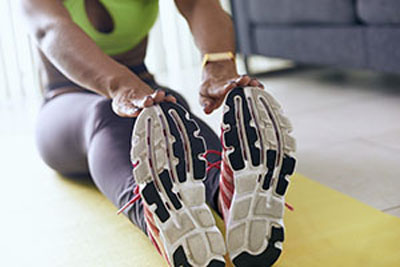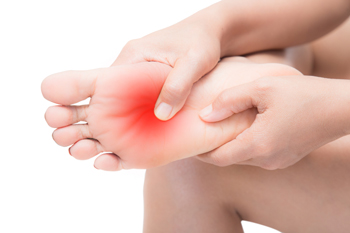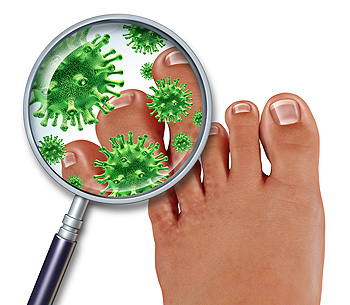Miami Shores (305) 631-2698

 A fear that many joggers may have is to endure an injury that may prevent running. One way this can be soothed is by having a strong body, and this may be accomplished by performing strength training exercises. When the muscles and tendons are strong, the gait may be more consistent, and this may help to prevent tripping or falling. There are specific stretching techniques that can be performed which may decrease the risk of injury, which may include standing on one leg for as long as possible while lifting the heel. This may be beneficial in strengthening the calves, toes, and ankles. Additionally, if you stand on a step, drop one heel, then lift onto your toes, the Achilles tendon may become stronger. This may allow for a stable landing while running. If you would like additional information on how to prevent running injuries involving the foot, it is suggested to speak to a podiatrist.
A fear that many joggers may have is to endure an injury that may prevent running. One way this can be soothed is by having a strong body, and this may be accomplished by performing strength training exercises. When the muscles and tendons are strong, the gait may be more consistent, and this may help to prevent tripping or falling. There are specific stretching techniques that can be performed which may decrease the risk of injury, which may include standing on one leg for as long as possible while lifting the heel. This may be beneficial in strengthening the calves, toes, and ankles. Additionally, if you stand on a step, drop one heel, then lift onto your toes, the Achilles tendon may become stronger. This may allow for a stable landing while running. If you would like additional information on how to prevent running injuries involving the foot, it is suggested to speak to a podiatrist.
All runners should take extra precaution when trying to avoid injury. If you have any concerns about your feet, contact Dr. Adam Auster of Florida. Our doctor will treat your foot and ankle needs.
How to Prevent Running Injuries
There are a lot of mistakes a runner can make prior to a workout that can induce injury. A lot of athletes tend to overstretch before running, instead of saving those workouts for a post-run routine. Deep lunges and hand-to-toe hamstring pulls should be performed after a workout instead of during a warmup. Another common mistake is jumping into an intense routine before your body is physically prepared for it. You should try to ease your way into long-distance running instead of forcing yourself to rush into it.
More Tips for Preventing Injury
If you have any questions, please feel free to contact our offices located in Miami Shores and South Miami, FL. We offer the newest diagnostic and treatment technologies for all your foot care needs.
Read more about Preventing Running Injuries Morton’s neuroma is a result of an inflamed nerve in the ball of the foot that causes pain, swelling, numbness, tingling, and sometimes burning. There are many treatment options for Morton’s neuroma, and they vary depending on the severity of the condition. The simplest option is RICE, which stands for rest, ice, compression, and elevation. This option is only useful in the very beginning stages of the neuroma and before it has become severe. Padding and orthotics can also be used to cushion and align the ball of the foot. Anti-inflammatory medications can be used as a form of pain relief, but they will not solve the problem. These are the easiest fixes for Morton’s neuroma and are only relevant for cases that are not too severe. In more extreme cases, injection therapy or surgery might be necessary. If you think you may have Morton’s neuroma, then it is strongly recommended you speak with a podiatrist about the right treatment options for you.
Morton’s neuroma is a result of an inflamed nerve in the ball of the foot that causes pain, swelling, numbness, tingling, and sometimes burning. There are many treatment options for Morton’s neuroma, and they vary depending on the severity of the condition. The simplest option is RICE, which stands for rest, ice, compression, and elevation. This option is only useful in the very beginning stages of the neuroma and before it has become severe. Padding and orthotics can also be used to cushion and align the ball of the foot. Anti-inflammatory medications can be used as a form of pain relief, but they will not solve the problem. These are the easiest fixes for Morton’s neuroma and are only relevant for cases that are not too severe. In more extreme cases, injection therapy or surgery might be necessary. If you think you may have Morton’s neuroma, then it is strongly recommended you speak with a podiatrist about the right treatment options for you.
Morton’s neuroma is a very uncomfortable condition to live with. If you think you have Morton’s neuroma, contact Dr. Adam Auster of Florida. Our doctor will attend to all of your foot and ankle needs and answer any of your related questions.
Morton’s Neuroma
Morton's neuroma is a painful foot condition that commonly affects the areas between the second and third or third and fourth toe, although other areas of the foot are also susceptible. Morton’s neuroma is caused by an inflamed nerve in the foot that is being squeezed and aggravated by surrounding bones.
What Increases the Chances of Having Morton’s Neuroma?
Morton’s neuroma is a very treatable condition. Orthotics and shoe inserts can often be used to alleviate the pain on the forefront of the feet. In more severe cases, corticosteroids can also be prescribed. In order to figure out the best treatment for your neuroma, it’s recommended to seek the care of a podiatrist who can diagnose your condition and provide different treatment options.
If you have any questions, please feel free to contact our offices located in Miami Shores and South Miami, FL. We offer the newest diagnostic and treatment technologies for all your foot care needs.
Read more about Morton's Neuroma A protruding bone on the side of the big toe may be referred to as a bunion. It generally causes discomfort, and this may affect the type of shoes that are worn. This condition occurs as a result of an enlargement of the joint at the bottom of the big toe. Consequently, this may cause the big toe to lean toward the other toes, and a bony lump may appear on the side of the big toe. There may be several noticeable symptoms associated with bunions, including pain and discomfort, redness, and tenderness. Arthritis may develop if this condition is not treated properly, and it may be difficult to wear specific types of shoes. Research has indicated that bunions may be caused by genetic traits, which may include flat feet, or abnormal foot structures. Additionally, wearing high heels that have inadequate room in the toe area may cause bunions to form. If you are afflicted with a bunion, it is suggested to speak with a podiatrist who can properly treat this condition.
A protruding bone on the side of the big toe may be referred to as a bunion. It generally causes discomfort, and this may affect the type of shoes that are worn. This condition occurs as a result of an enlargement of the joint at the bottom of the big toe. Consequently, this may cause the big toe to lean toward the other toes, and a bony lump may appear on the side of the big toe. There may be several noticeable symptoms associated with bunions, including pain and discomfort, redness, and tenderness. Arthritis may develop if this condition is not treated properly, and it may be difficult to wear specific types of shoes. Research has indicated that bunions may be caused by genetic traits, which may include flat feet, or abnormal foot structures. Additionally, wearing high heels that have inadequate room in the toe area may cause bunions to form. If you are afflicted with a bunion, it is suggested to speak with a podiatrist who can properly treat this condition.
If you are suffering from bunion pain, contact Dr. Adam Auster of Florida. Our doctor can provide the care you need to keep you pain-free and on your feet.
What Is a Bunion?
Bunions are painful bony bumps that usually develop on the inside of the foot at the joint of the big toe. As the deformity increases over time, it may become painful to walk and wear shoes. Women are more likely to exacerbate existing bunions since they often wear tight, narrow shoes that shift their toes together. Bunion pain can be relieved by wearing wider shoes with enough room for the toes.
Causes
Symptoms
In order to diagnose your bunion, your podiatrist may ask about your medical history, symptoms, and general health. Your doctor might also order an x-ray to take a closer look at your feet. Nonsurgical treatment options include orthotics, padding, icing, changes in footwear, and medication. If nonsurgical treatments don’t alleviate your bunion pain, surgery may be necessary.
If you have any questions, please feel free to contact our offices located in Miami Shores and South Miami, FL. We offer the newest diagnostic and treatment technologies for all your foot care needs.
Read more about What Are Bunions? The fungus that is known as athlete’s foot typically thrives in warm and moist places. The skin on the feet may be a desired environment for this type of fungus to live, and that may be a result of wearing shoes and socks for the majority of the day. It generally lives between the toes, and the symptoms include itchiness, redness, and flaky skin. Additionally, this type of fungus may be found on public shower room floors, locker rooms, and other contaminated surfaces. If you frequent these types of places, it is suggested that appropriate shoes are worn, and this may aid in preventing the fungus from entering the skin. If a mild case of athlete’s foot is experienced, over the counter treatments may be successful in treating this condition. If you have pain and discomfort originating from this ailment, it is suggested to speak to a podiatrist who can offer proper treatment techniques.
The fungus that is known as athlete’s foot typically thrives in warm and moist places. The skin on the feet may be a desired environment for this type of fungus to live, and that may be a result of wearing shoes and socks for the majority of the day. It generally lives between the toes, and the symptoms include itchiness, redness, and flaky skin. Additionally, this type of fungus may be found on public shower room floors, locker rooms, and other contaminated surfaces. If you frequent these types of places, it is suggested that appropriate shoes are worn, and this may aid in preventing the fungus from entering the skin. If a mild case of athlete’s foot is experienced, over the counter treatments may be successful in treating this condition. If you have pain and discomfort originating from this ailment, it is suggested to speak to a podiatrist who can offer proper treatment techniques.
Athlete’s foot is an inconvenient condition that can be easily reduced with the proper treatment. If you have any concerns about your feet and ankles, contact Dr. Adam Auster from Florida. Our doctor will treat your foot and ankle needs.
Athlete’s Foot: The Sole Story
Athlete's foot, also known as tinea pedis, can be an extremely contagious foot infection. It is commonly contracted in public changing areas and bathrooms, dormitory style living quarters, around locker rooms and public swimming pools, or anywhere your feet often come into contact with other people.
Solutions to Combat Athlete’s Foot
Athlete’s foot can cause many irritating symptoms such as dry and flaking skin, itching, and redness. Some more severe symptoms can include bleeding and cracked skin, intense itching and burning, and even pain when walking. In the worst cases, Athlete’s foot can cause blistering as well. Speak to your podiatrist for a better understanding of the different causes of Athlete’s foot, as well as help in determining which treatment options are best for you.
If you have any questions please feel free to contact our offices located in Miami Shores and South Miami, FL. We offer the newest diagnostic and treatment technologies for all your foot and ankle needs.
Read more about How to Deal with Athlete's Foot